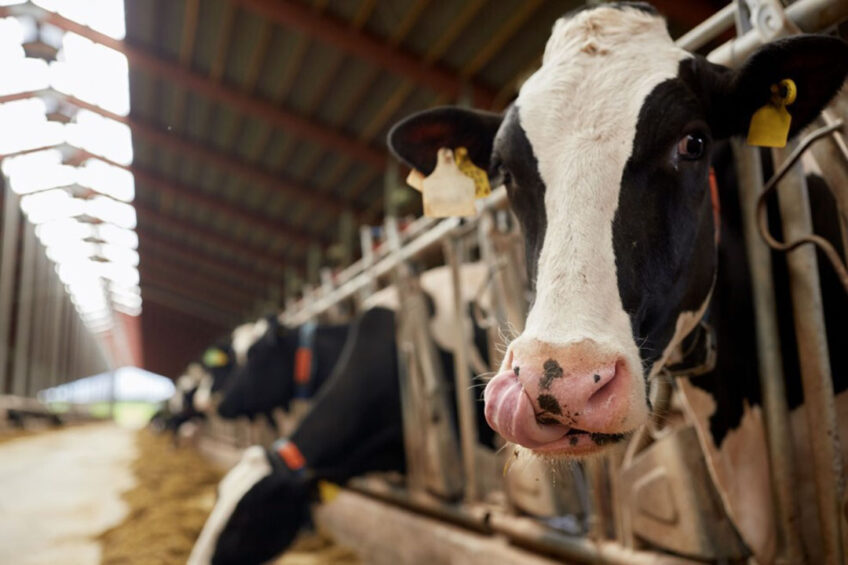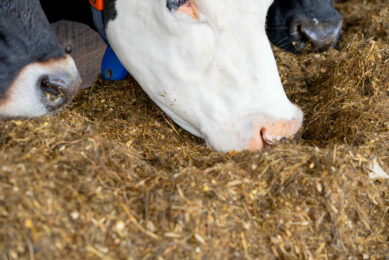Managing dairy cow stress and health through nutrition

High-producing dairy cows are constantly exposed to metabolic, environmental and nutritional challenges induced by calving, high production, overcrowding, diet changes, weather conditions (heat stress) and so on. Managing these challenges is crucial to maintain good fertility, health and productivity.
Challenges that cause stress can lead to reduced milk production, inefficient feed utilisation and an increased risk of diseases and infections, such as mastitis.
Stress is also known to cause depressed immunity, often leading to systemic inflammation and increased susceptibility to disease. For the farmer, this can mean reduced dairy cow productivity, alongside increased treatment and replacement costs.
Establishing different strategies to reduce stress can help to improve animal health, welfare and productivity, especially during high-risk periods. Such management strategies should focus on providing adequate cooling during summer, sufficient space to avoid overcrowding and competition at the feed trough, dry and clean bedding, good transition management with proper grouping, and minimal movement between pens.
Supplementing with active ingredient – yeast postbiotics
Alongside such strategies, the planned supplementing of dairy cows with active ingredients, such as yeast postbiotics, can help strengthen the immune system.
An inadequate immune response during high-stress periods, such as calving, can cause systemic inflammation and divert energy from milk production. During the first few days of postpartum, plasma concentrations of inflammatory lipids (ceramides and oxylipids) and acute phase proteins are elevated, leading to a suboptimal immune response to pathogens. The post-calving period in dairy cows contains the highest intensity of disease incidents, such as mastitis, metritis and metabolic disorders.
Supplementing dairy cows during high-risk periods with the yeast postbiotic Safmannan helps to strengthen their natural defences and regulate the response of the innate immune system, potentially helping to reduce negative health issues.
Safmannan has been shown to be uniquely able to bind certain pathogenic bacteria (Eschericia coli, Salmonella, Clostridium and Listeria) in the gut, thus reducing their negative impact. This has been demonstrated through a series of in vitro and in vivo trials.
Safmannan has also been shown to be able to interact with the immune cells of an innate immune system, such as macrophages and dendritic cells, which are situated in the gut. This helps to deliver an optimal immune cell response to pathogen and metabolic challenges, strengthening the animal’s natural defences.
How does Safmannan work?
Pathogen binding: Due to its specific surface structure – composed of interlinked mannoproteins and beta-glucans – certain pathogenic bacteria attach to its surface, mitigating their ability to colonise the intestinal epithelium. The lowering of pathogen pressure in the gut is also associated with reduced levels of endotoxins and gut inflammation.
Immune modulation: The unique combination of active molecules, present on the surface of Safmannan, effectively interacts with innate immune cells (macrophages and dendritic cells) situated in the mucosa of the small intestines, thereby activating specific pattern recognition receptors. Activating these receptors creates a more adequate immune response to pathogens.
Field study: Safmannan was supplemented at 10 g/cow/day for 106 days to a herd of 300 high-risk dairy cows with a history of increased health problems. The study was based on an on-off sequence field trial in South Dakota, USA.
Herd health records were reviewed to identify morbidity during 2 periods: a reference period of 6 months (control) and a 4-month period of supplementation with Safmannan. Morbidity causes, recorded during the study, included abortion, displaced abomasum (DA), milk fever, retained placenta (RP), anorexia, pneumonia and death. An F-T test was used to analyse supplementation effects, with a one-tailed T-test being used to compare differences. The results were considered statistically significant when P <0.10. (See Table 1).
Milk samples were collected during the supplementation period to determine milk composition. The samples were analysed through a calibrated mid-infrared milk analyser.
Supplementation with Safmannan significantly reduced negative health issues with both somatic cell counts (SCC) and farm profitability improving compared to the reference period. The return on investment (ROI) from using Safmannan was estimated at 4.4:1, based on the incidence of negative health issues per 100 cows and supplementation costs, compared with the cost of negative health issues in non-supplemented cows. ROI increased to 5:1 when account was also taken of the decrease in clinical mastitis and the value of avoided milk loss.
Conclusion
Supplementation of dairy cows with Safmannan yeast postbiotics at a dose of 10-15 g/cow/day can help to mitigate negative health issues in high-risk dairy cows, while also reducing SCC at a herd level. Safmannan can stimulate cow immunity to combat different pathogens and reduce inflammation by impacting the expression of anti-inflammatory cytokines. Mortality rates and other health issues in a herd represent additional costs, leading in many cases to economic losses for farmers. By supporting a healthy gut and immune system, Safmannan has been demonstrated to be a cost-efficient supplement for improving dairy farm performance.
Join 13,000+ subscribers
Subscribe to our newsletter to stay updated about all the need-to-know content in the dairy sector, two times a week.










